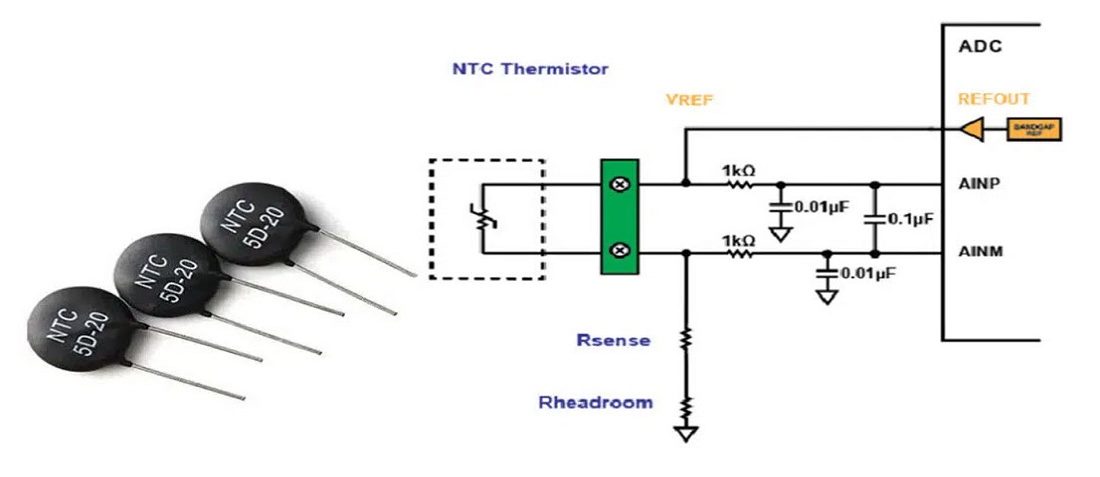
Thermistor-Based Temperature Sensing System Optimization and Evaluation
- Posted by doEEEt Media Group
- On June 23, 2023
- 0
This article by Jellenie Rodriguez and Mary McCarthy discusses thermistor-based temperature sensing system optimization and evaluation.
Introduction
As discussed in the the article Thermistor-Based Temperature Sensing System Explained, different challenges are involved in designing and optimizing thermistor-based application solutions. These are sensor selection and circuit configuration discussed in the previous article. Additional challenges are measurement optimization, which includes the ADC configuration and selecting the external components while ensuring that the ADC is operating within specification, and the system optimization to achieve the target performance and determine the error sources associated with the ADC and the overall system.
Thermistor System Optimization
With an easy-to-use tools such as the Thermistor Configurator and Error Budget Calculator, customers can easily configure the thermistor in their system, including the wiring and connection diagram. The agency designs the thermistor system with an excitation voltage in a ratiometric configuration. It also allows customers to adjust the settings, such as the sensor type, measured temperature range, linearization, and external components, as shown in Figure 1. It ensures that both the ADC and thermistor sensor are used within specification. So, if a customer selects an option that is not supported, the tool flags that this is an error condition. For example, if a customer selects a maximum temperature value outside the operating range of a specific thermistor model, an error will be displayed, as shown in Figure 2. Following the recommended range value will ensure the system configuration meets the sensor and electronic operating conditions.
The tool enables the user to understand the different error sources and allows design optimization. Note that the device is designed around the AD7124-4/AD7124-8, so it also determines the number of sensors connected to a single ADC. To appreciate the importance of the tool, let’s walk through the different design considerations used in thermistors.
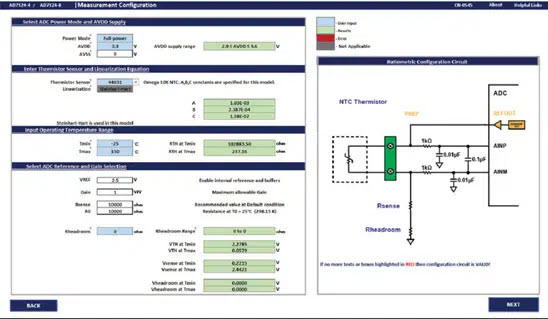
Figure 1. A thermistor configurator.
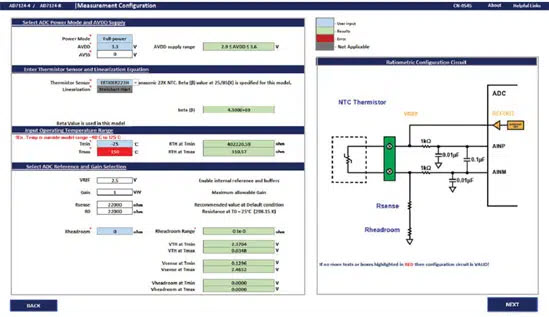
Figure 2. An out-of-bound condition.
System Configuration (Excitation, Gain, and External Components)
Like RTDs, thermistors are also susceptible to self-heating as resistors dissipate power when a current flows through them. Thus, the designer must keep the operating current of the thermistor as low as possible so that its power dissipation will not significantly affect the measurement results. Primarily, designers tend to select higher values of excitation voltage to generate higher output voltages so that they can fully use the ADC’s input range. However, since the thermistor sensor has a negative temperature coefficient, its resistance decreases as the temperature increases, so a high value of current flowing through it will result in higher power consumption, leading to self-heating.
A thermistor does not require higher excitation source values on the brighter side. Its higher sensitivity characteristics can generate an output voltage from millivolts to volts over the specified temperature range. Therefore, using an excitation voltage such as the ADC reference voltage value is sufficient and allows a ratiometric configuration. By setting the PGA gain to 1, this technique also ensures that the entire thermistor output voltage range or the voltage seen on the analogue input of the ADC will always be within the ADC operating input range. The tool uses the internal 2.5 V reference available on the AD7124-4/AD7124-8. When a gain of 1 is used, the PGA is also powered down, reducing the overall current consumption. The AD7124-4/AD7124-8 also incorporate analogue input buffers that allow infinite resistance and capacitance values to be used externally, making them ideal for direct connection to external resistive type sensors such as thermistors or connecting electromagnetic capability (EMC) filtering without adding any error. However, when using the ADC at a gain of 1 with analogue input buffers enabled, it is necessary to ensure that the headroom required for the correct operation is met. The tool also allows designers to balance the selection of external components, including the allowable range for external headroom resistors, the recommended sense resistor value, and its tolerances and drift performance. The thermistor tool also provides a list of commonly used thermistor types. It allows options where the designer can enter the nominal value and beta (β) or Steinhart-Hart constants of any NTC thermistor. The accuracy of the sensor, external components, and its contributions to the system error, along with the effect of the linearization technique used by the sensor, will be discussed later.
Filtering and Power Consideration
Sigma-delta ADCs use a digital filter, and the frequency response of the digital filter provides 0 dB of attenuation at the sampling frequency and multiples of the sampling frequency. This means the filter response is reflected around the sampling frequencies, so an antialiasing filter in the analogue domain is required. Since sigma-delta ADCs inherently oversample the analogue input signal, the design of the antialiasing filter is simplified such that a simple (single pole) RC filter is sufficient. For example, the AD7124-4/AD7124-8 will only require a one kΩ resistor in series with each analogue input, a 0.1 μF capacitor from AINP to AINM, and a 0.01 μF from each analogue input pin to AVSS.
Extra robustness is one of the top priorities in most industrial applications or process control. A system may experience noise, transients, or interference from its neighbouring components or environment. Large R and C values on the analogue input are typically used for EMC purposes. However, please take note that when the converter is operated in an unbuffered mode with a gain of 1, the inputs look directly into the sampling capacitor of the modulator, so large RC values can cause gain errors as the ADC does not have sufficient time to settle between sampling instants. Buffering the analogue inputs prevents these errors.
Interference from the mains power supply can also affect measurement results. Thus, when devices are powered from the main supply, 50 Hz/60 Hz rejection is also a system requirement. Another benefit of a narrow bandwidth sigma-delta ADC such as the AD7124-4/AD7124-8 is it offers flexible digital filtering options that can set notches at 50 Hz and 60 Hz.
The selected filter type, and the programmed output data rate, influence the settling time and noise performance. The device also offers different power modes allowing users to tune the ADC for optimum power, speed, or performance. The system’s current consumption or power budget allocation is highly dependent on the end application. The device can be configured in full power mode if the plan requires higher output data rates and better noise performance. If limited power consumption is needed at reasonable speeds and with proper implementation, the device can be operated in mid or low-power mode.
Aside from accuracy or performance, timing is also a factor. In most applications, a specific time must be met to perform all measurements. If multiple channels are enabled—that is, various sensors are used—a designer must consider the latency through the digital filter. In multiplexed ADCs, when multiple channels are allowed, a settling time is required every time the channel is switched; thus, selecting a filter type with a longer settling time (sinc4 or sinc3) will lower the overall throughput rate. In this case, a post filter or an FIR filter is helpful to provide reasonable simultaneous 50 Hz/60 Hz rejection at lower settling times and thus increase the throughput rate. All filter options and a subset of the output data rate selection can be tested via the Thermistor Configurator and Error Budget Calculator. This will generate the expected noise performance and feed to the system error calculations discussed in the next section. Note that a complete selection of output data rate/FS value/throughput rate is available on the Virtual Eval online tool. Virtual Eval shows the timing for the different scenarios that can be used to evaluate the timing performance of the ADC, whether measuring a single or multiple thermistor sensors.
Error Budget Calculations
As discussed, the Thermistor Configurator and Error Budget Calculator allow users to modify the system configuration for optimum performance. The error budget calculator shown in Figure 3 assists the designer in understanding the errors associated with the ADC and mistakes from the system configuration with and without internal or system calibrations. The system error pie chart indicates which part of the system contributes most to the overall system error. So, a customer can modify the ADC or system configuration to achieve optimum performance.
As observed in Figure 3, the error due to the ADC is not the significant error contributor to the overall system error. The external components, along with their temperature coefficients or temperature drift specifications are usually the main error contributors across the system when operating at the full temperature range.
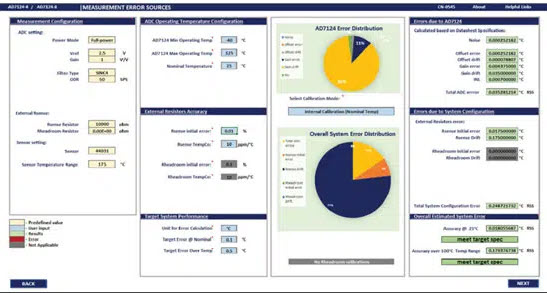
Figure 3. A thermistor error budget calculator.
For example, if we change the sense resistor tempo from 10 ppm/°C to 25 ppm/°C in the tool, you will see that the overall system error will be significantly increased. Therefore, selecting the sense resistor with better initial accuracy and a lower temperature coefficient is essential to minimize any possible temperature drift errors.
The AD7124-4/AD7124-8 offer different calibration modes that can be used to reduce measurement errors further. Upon power-up or software initialization, an internal calibration is recommended to remove the ADC’s gain and offset errors at nominal temperature. Please take note that the tool uses a gain setting of 1. The AD7124-4/AD7124-8 are factory calibrated at an increase of 1, and the resulting gain coefficient is the default gain coefficient on the device. Therefore, the device does not support further internal full-scale calibrations at a gain 1. Note that internal calibrations at nominal temperature remove the AD7124-4/AD7124-8 gains and offset errors only, not the growth and cancel errors and any drift errors created by the external circuitry. Performing system calibrations can remove external mistakes. Performing calibrations at different temperature points can also improve drift performance. However, this will add additional cost and effort and may not be suitable for some applications.
Fault Detection
For any harsh environment or for applications where safety is a priority, diagnostics features are becoming more critical and even required. Even for nonsafe designs, diagnostics add robustness, ensuring that all design blocks are functioning correctly and the processor is receiving and acting on valid data only. The embedded diagnostics in the AD7124-4/AD7124-8 reduce the need for external components to implement diagnostics, resulting in a smaller, simplified, time and cost savings solution. Diagnostics include:
- Checks the voltage level on the analogue pins to ensure it is within the specified operating range
- A reference voltage check
- A cyclic redundancy check (CRC) on the serial peripheral interface (SPI) bus
- A CRC on the memory map
- Signal chain checks
- These diagnostics lead to a more robust solution.
Thermistor System Evaluation
After conceptualizing the system design and understanding the expected system performance, the next step for a designer is to prototype and validate the performance of the invention. CN-0545 is a Circuits from the Lab® reference design that leverages EVAL-AD7124-4/EVAL-AD7124-8 evaluation boards and its evaluation software to provide measurement data for a 0.1°C accuracy thermistor. The circuit in CN-0545 uses a ten kΩ, type 44031 NTC thermistor sensor, which is specified to measure from –50°C to +150°C with an accuracy of ±0.1°C between 0°C and +70°C and a ±1°C over the more comprehensive temperature range.
Figure 4 shows measurement results from CN-0545. This data was captured with the AD7124-4/AD7124-8 evaluation boards, including a thermistor demo mode that measures the thermistor resistance and calculates the equivalent °C using the sensor’s Steinhart-Hart constants. The plot shows the actual performance results. If you compare it to the error budget calculator, the actual results may appear better than the estimations provided by the tool. This difference is due to the device using maximum values for all parameters, providing a worst-case circuit analysis. In practice, the sensor drift, initial accuracy, and temperature drift of the electronics and components used in the system will not always be at their specified maximum values.
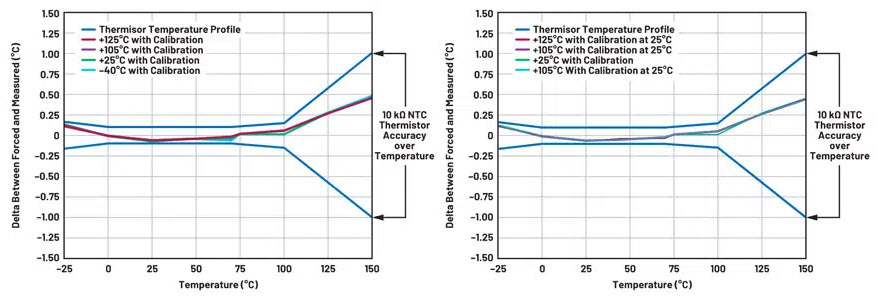
Figure 4. Thermistor temperature accuracy measurement, post filter, low power mode, 25 SPS.
Providing such flexible validated reference circuit boards is valuable to system designers as it lessens the design cycle and provides good circuit techniques. Along with the hardware, the software supports the different system optimization and calibration techniques for each thermistor sensor to meet the market demands where they need easy-to-use, high accuracy, precision, and reliable signal chain solutions.
Providing the designer tool and hardware demo mode circuit can ease the design process but system designers have different ways of handling measurements and may have used different controllers for software processing. To further ease the development process, a simple firmware application, AD7124 Temperature Measurement Demo Example, can generate custom code with a choice of a controller board, a software platform, device configurations, and a measuring sensor such as a thermistor. This open-source Mbed platform provides the ability to support over 150+ controller boards with or without modifications. Thus, it enables rapid prototyping and a faster development phase.
- Managing EEE components for LEO and lower cost space missions - December 17, 2024
- Filtering Characteristics of Parallel-Connected Fixed Capacitors in LCC-HVDC - November 21, 2024
- ALTER SPACE TEST CENTER: testing approaches for New Space - September 30, 2024

0 comments on Thermistor-Based Temperature Sensing System Optimization and Evaluation